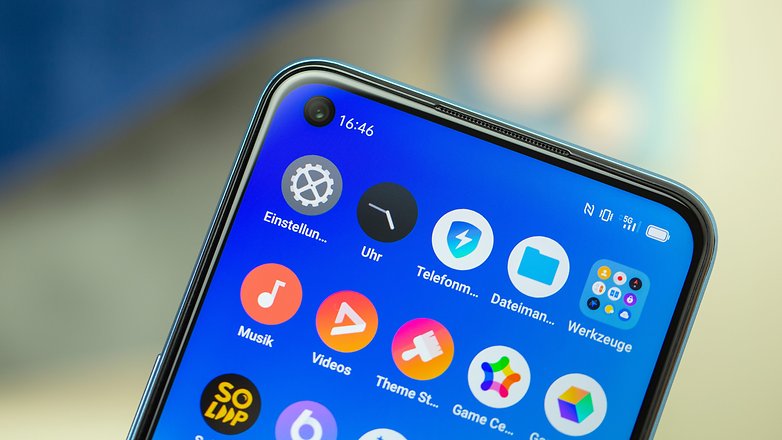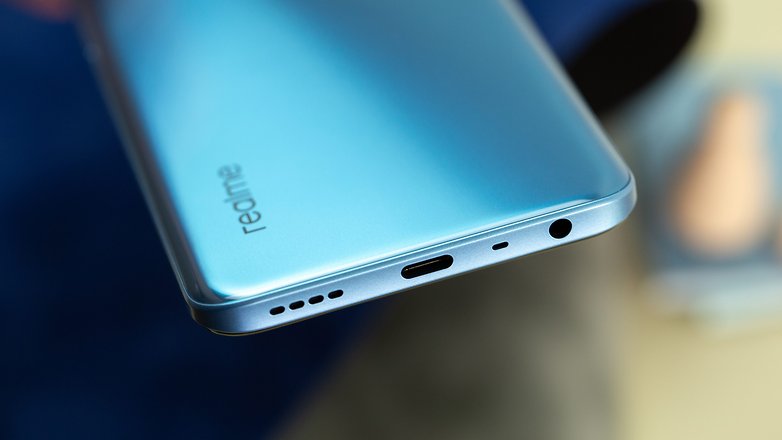The Realme 8 5G has smartphones like the Redmi Note 9T in its sights with a recommended retail price of €199 while packing in a 5G-capable SoC. This means you can finally take advantage of your 5G contract that your mobile network operator offers without having to break the bank for a flagship device. However, the question remains: is it worth buying the 5G-capable Realme 8? Let us take a deeper dive in our hands-on of the Realme 8 5G.
Good
- ✓5G speeds of up to 600 Mbit/s in Berlin
- ✓Beautiful IPS panel with 90 Hertz refresh rate
- ✓5,000 mAh battery
Bad
- ✕Triple camera has no ultra wide-angle lens
- ✕Camera bump is unsightly
- ✕Fast charging maxes out at 18 watts
Initial impressions: Cheaper price comes at a cost
The most interesting thing about the Realme 8 5G is the recommended retail price of €199 - and that is not a bad thing at all! The Chinese manufacturer offers a viable alternative to devices such as the Xiaomi Redmi Note 9T or the recently introduced Redmi Note 10 5G in Europe. In a sense, this is a smart move as the company takes aim at its rivals.

However, Realme has stripped down their latest release way too much compared to the Realme 7 5G, which once went on sale at a recommended retail price of €280. The display comes with a 90 Hz refresh rate instead of 120 Hz, in addition to a less powerful SoC, while offering fast charging at only 18 watts instead of 30 watts, with a missing ultra-wide-angle lens in the triple camera setup behind.
So you might want to think twice about maximizing your 5G contract with the previous model, which has already seen a price drop. However, I'll be using the Realme 8 5G for a few more days to see whether the savings is worth the price of admission. Read on if I have piqued your interest in the Realme 8 5G!
Design & Display
The Realme 8 5G measures 162.5 x 74.8 x 8.5 millimeters and tips the scales at 185 grams. Realme has thrown in a 6.5-inch LCD display with a decent 2,400 x 1,080 pixels resolution while offering a 90 Hz refresh rate. While the front is all glass, one should expect a polycarbonate back on the Realme 8 5G, of which Realme duly obliged.
I liked the:
- Slim and thin form factor.
- Very bright LCD display.
- 90 Hz refresh rate is always welcome.
I did not like the:
- Missing 120 Hz refresh rate that is found on its predecessor (Realme 7 5G).
- Quad-cam camera bump design is ostentatious.
- Fingerprint sensor located on the side.
At first glance, the Realme 8 5G's panel caught my attention. This is because it performs impressively in daily use as opposed to just seeing the details on the specifications sheet. LCD displays are often seen as a significantly inferior alternative to OLED, but that's by no means given. The 6.5-inch panel in the Realme 8 5G has an exceptional degree of brightness as it offers a high contrast ratio.
At first glance, I even suspected that Realme was using an OLED panel. I only became skeptical about it when I realized the refresh rate stood at 90 Hz, because this is one feature that can be found on LCD displays in smartphones that do not pass the €200 price point. 90 Hz is good enough for this Realme handset, especially when you are busy scrolling through lists.

Overall, the workmanship of this smartphone is decent. As with the Realme 7, the manufacturer relies mainly on plastic as the material of choice for both the sides and backplate. It is not that bad in execution, and it is nice to note that Realme has also spared us the huge "Dare to Leap" words emblazoned on the Pro model. Now that's gaudy if anything!
Compared to the previous model, I find it a bit of a shame that Realme only offers a 90 Hz refresh rate instead of 120 Hz. However, since the Realme 7 5G was also a bit more expensive, this is a sensible cost-cutting measure that won't affect most of our readers. The camera bump could have been better executed though. By including the letters "AI" in a circle, it does fool some of the less observant folk that there is a fourth camera in place when in reality, only three cameras are available. Check it out for yourself!
Decent performance and technology
The 5G version of the Realme 8 is powered by a MediaTek Dimensity 700 chipset which provides you with access to 5G networks. Apart from that, it is an entry-level processor, so do not expect too much performance from it. In addition, the SoC supports Wi-Fi 5 and Bluetooth 5.1 connectivity.
I liked the:
- 5G processor.
I did not like the:
- Slower processor as its predecessor carried the faster Dimensity 800 SoC.
There's not much that can be said about the Realme 8 5G's performance from just a quick hands-on session. Of course, the integration of a 5G processor is worth noting considering the relatively low price point. However, any positive impressions that I had evaporated when I looked at the rest of the hardware specifications.
This is because the Realme 7 5G is powered by the more powerful Dimensity 800 SoC from MediaTek. In the Xiaomi Redmi Note 9T 5G smartphone which shares a similar price point, one can find the Dimensity 800U SoC which is more oriented toward gaming. Since that proved to be not too powerful in our Redmi Note 9T review, I'm curious to see the benchmarks of this Realme handset.

However, 5G performance looked to be rather promising in our office that is located in Berlin. As with my 5G test with the Redmi Note 9T, I could reach the dizzying heights of 605 Mbps download speeds. So if you live in the right place and have an appropriate mobile plan, you can surf the Internet really fast with the Realme 8 5G.
Aside from 5G support, the rest of the smartphone's features typically fall within the mid-range market. This means that you can connect to Wi-Fi networks with Wi-Fi 5 and hook up to your Bluetooth 5.1-enabled headphones.
Camera: Fool me once, shame on you!
At first glance, the Realme 8 5G actually impressed me a lot through a visual deception. I say so because Realme's design points to a quad-camera setup when you look at the back, when in reality there are only three cameras. This design in no way makes the 48-megapixel triple camera setup look any better, with functionally useless 2-megapixel macro and depth cameras accompanying it.

I liked the:
- Decent photos captured during the day.
I did not like the:
- Triple camera configuration has no additional focal length.
- 2-megapixel macro camera.
Throughout my hands-on experience, I was blessed to be in Berlin as summer began to emerge, allowing the Realme 8 5G to snap photos under optimal lighting conditions. Below are some impressions of the 48MP triple camera, of which I will include a few lines of comments for additional context.

Let's start with a 48-megapixel image from the main camera. I cropped this to 16:9 for the upload and presented it in 4K resolution. What I liked were the nice colors and the good level of exposure which offered pleasant contrasts. However, upon zooming in, you will quickly see a bit of a watercolor effect, resulting in details being blurred out.

Instead of using the zoom function in Photoshop, let's try the zoom function on the smartphone itself. Everything is purely digital, of which you can check out the results for yourself. Even at 2x magnification, the level of detail decreases drastically. I would highly recommend you to simply get closer to your subject!

I do not mean to gripe and moan, but the HDR mode personally surprised me. Even under such extreme situations including having a very bright backlight, details on the balcony above me can be seen. The result doesn't look very natural, but it does showcase the efficiency of Realme's software and its sensor's dynamic range.

Finally, here is a couple of selfies. On the left, you can see the front camera's work in portrait mode, and on the right, the main camera. The most significant difference between the two would be the different skin tones of which Realme's algorithm probably found my skin far too wrinkled! I'll find out for sure if you can turn off this beauty filter in the detailed review!
Battery: 5,000 mAh with lame Fast Charging
Realme has included a large battery capacity of 5,000 mAh within the Realme 8 5G that measures just 8.5 mm thin. While the Realme 8 Pro excelled with its 50-watt Fast Charge capability, this 5G model only offers 18 watts of Fast Charging. In other words, expect significantly longer charging times.
What I liked:
- Large capacity battery.
What I disliked:
- Fast charging at only 18 watts.
- No wireless charging support.
Since I could only use the Realme 8 5G for an entire day in the office, I can't say too much about the battery life yet. You'll have to wait a few more days for that, as I'll naturally be using the smartphone for a longer time.
However, when reading Ruben's review of the Realme 8 Pro and how 50W Fast Charging is supported on that handset, the Realme 8 5G's 18-watt Fast Charging capability pales in comparison. I see it as a waste since that was a real plus point for the Pro model. Once again, this was one cost-cutting measure that Realme had to embark upon to keep the price below the €200 mark.
Sub-€200 price point a result of many cost-cutting measures
If you place the Realme 8 5G in context and take a look at the Pro version, its predecessors, and other models in the market, one thing becomes clear: Realme really had to implement plenty of cost-cutting measures to achieve a sub-€200 price point. Of course, all of it has become necessary in order to make room for a 5G processor within its chassis.
Hence, you are now at a crossroads here with all the compromises made. Do you want 5G support or are you happy to live with LTE and a bunch of superior hardware features? If you prefer the former, then the Realme 8 5G is an interesting entry-level model that should suit basic users, otherwise you might be better off with an LTE model that has better hardware specifications.
After all, 5G networks are still not widespread everywhere, so you would most probably be plumping for a new 5G-capable handset a couple of years down the road anyway.
Read More Open link https://ift.tt/3himLyB
0 Response to "Realme 8 5G hands-on: A viable Redmi Note 9T alternative?"
Posting Komentar